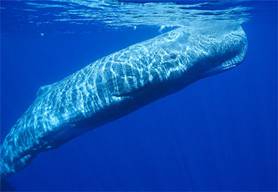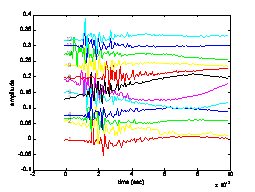George E. Ioup,
Juliette W. Ioup,
Lisa A. Pflug,
Arslan M. Tashmukhambetov
Department of Physics,
University of New Orleans,
New Orleans, LA 70148,
geioup@uno.edu
Natalia A. Sidorovskaia
Physics Department,
University of Louisiana at Lafayette,
Lafayette, LA
Charles H. Thompson
NOAA/NMFS/SEFSC,
Stennis Space Center, MS
Christopher O. Tiemann
Applied Research Laboratories,
University of Texas at Austin,
Austin, TX
Lay-language version of paper 2pSP4
Presented on Tuesday, November 11, 2008
156th Meeting of the Acoustical Society of America
Toothed whales (odontocetes), including sperm and beaked whales, emit very loud clicks into the water. They do this in order to echolocate: they listen to the echoes from the surface and the bottom to know where they are in the water column, and they listen to echoes from their prey in order to locate their food. A fascinating research question is whether whales can tell which of their comrades is clicking from subtle differences in the clicks emitted by each whale. A very interesting related question is whether we humans who are also listening (using passive acoustic hydrophones in the water) can identify each whale from the properties of their clicks.
Sperm whales, which have very large heads (up to 20 ft long) and emit extremely loud clicks of 3 to 6 thousandths of a second duration, are especially intriguing because they also emit clicks which are thought to be for communication purposes. A group of these clicks, called a coda, has clicks spaced about 4 hundredths of a second apart, and 6 to 15 are emitted in a row at reasonably regular intervals of about 4 tenths of a second. The total duration is up to ½ second. A significant amount of research has been done by others studying the rhythmic patterns of the clicks within these codas. It is known that the rhythms vary by sperm whale clans distributed geographically. There is some research into the hypothesis that the rhythms may vary from individual to individual, and that this might be a way that individuals identify each other and exchange information.
Our research uses a different approach. We study the time properties of the individual clicks and also their properties after they are analyzed into component waves of different frequencies (the way the human ear analyzes sounds). We are using these ways of representing the clicks to understand whether sperm whales could use the properties of these clicks to identify each other, and whether we can use the properties of the clicks to identify which whale is speaking. Our hope is that this analysis will apply to echolocation clicks of both sperm and beaked whales, as well as the clicks in codas, although the research into that aspect is more difficult. We have been using some of the techniques which collectively are referred to as cluster analysis, to associate similar codas with each other, assuming that similar codas come from one whale. We have some promising results. What is needed is a way to know if our identifications do indeed correspond correctly to individual whales. Recently we have begun a line of investigation in which we track the whales acoustically at the same time we are identifying them. If we are successful, this will tell us if the clicks we associate with an individual do indeed come from the same whale. If we are able to identify individual whales, the research can have significant benefit both for behavioral studies of the whales and for population estimation.
We are part of a research team which was the first to record beaked whales in the Gulf of Mexico. These whales are shy and therefore most knowledge of them has only recently become available. We are currently analyzing these recordings.

Fig. 1. Sperm whale

Fig. 2. Analysis of the clicks of one coda into waves of different frequencies. Clicks are vertical lines plotted versus time on the horizontal axis. The vertical axis shows the frequency. The color shows the contribution of waves at each frequency. Red corresponds to the most intense and blue to the least intense. Notice that the pattern versus frequency persists across all clicks in the coda. Other codas have clicks which are similar to each other and can either be the same or different from these.

Fig. 3. Amplitude (proportional to pressure received at the hydrophone) plotted versus time for different clicks within one coda. The vertical axis is offset for each click so that they can be viewed more clearly. The clicks are similar to each other. Other codas have clicks which are similar to each other and can either be the same or different from these.